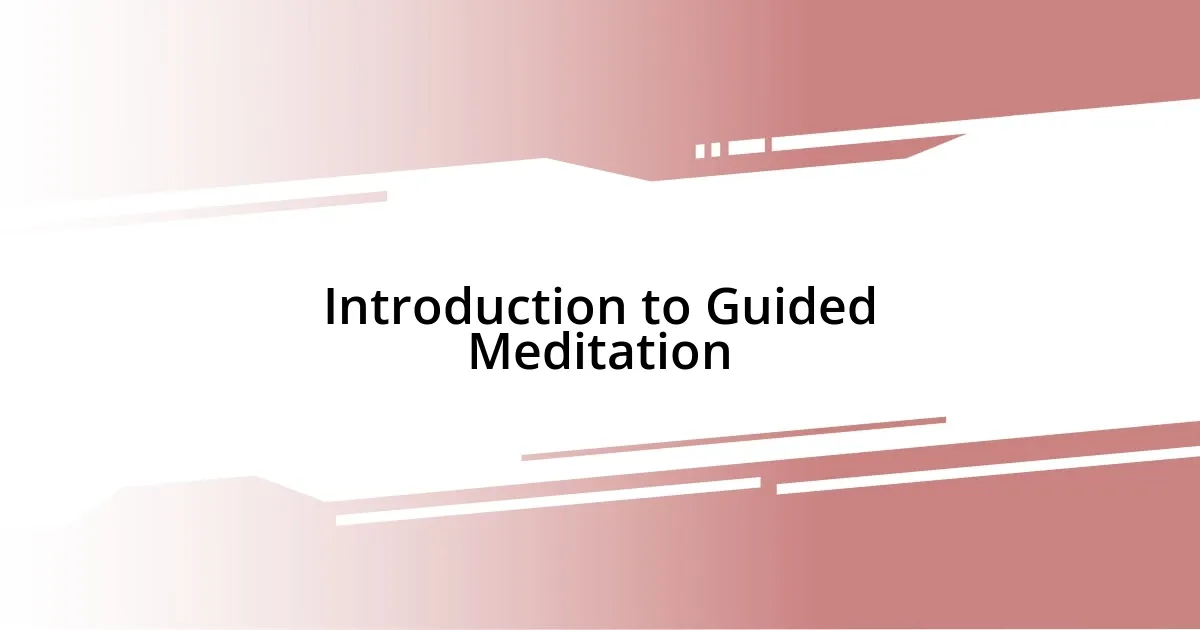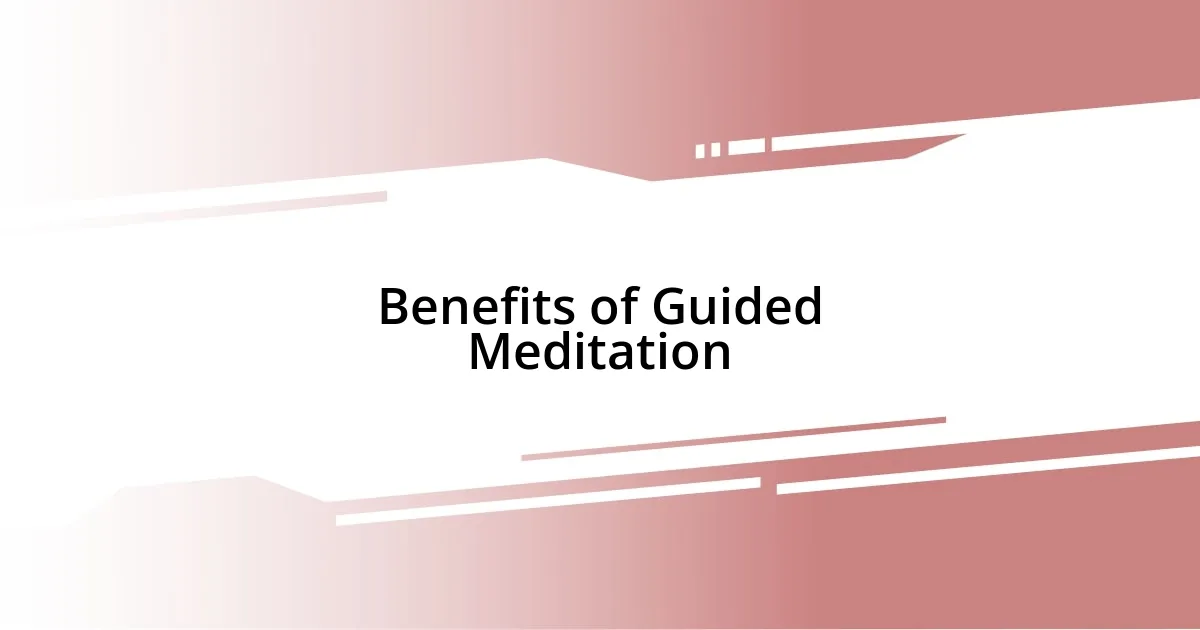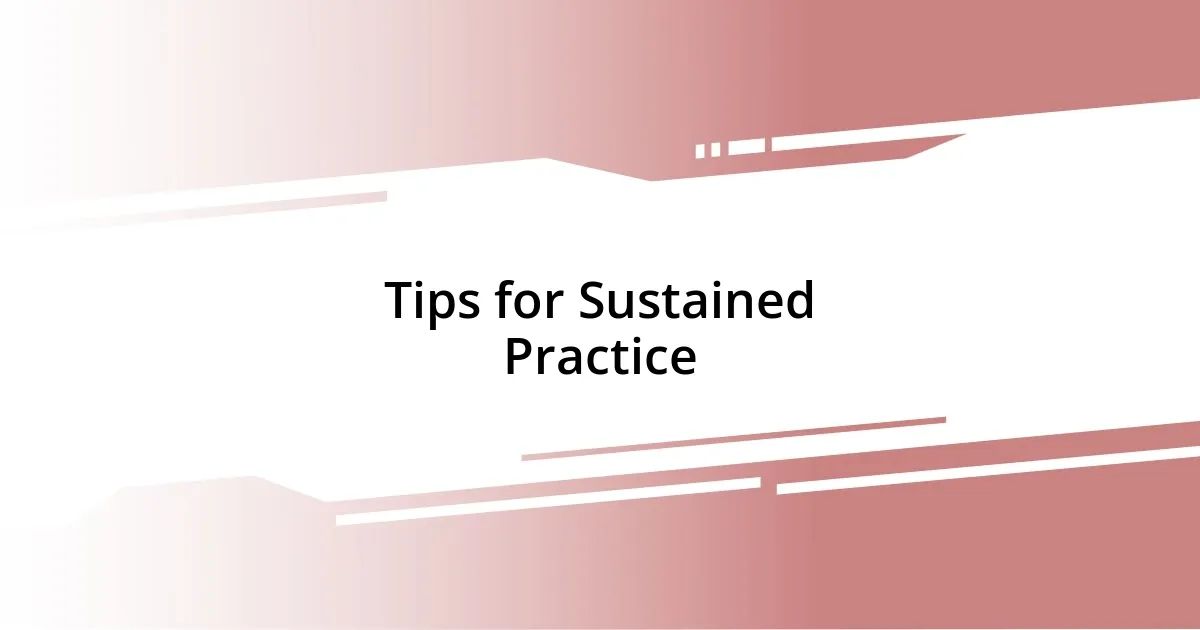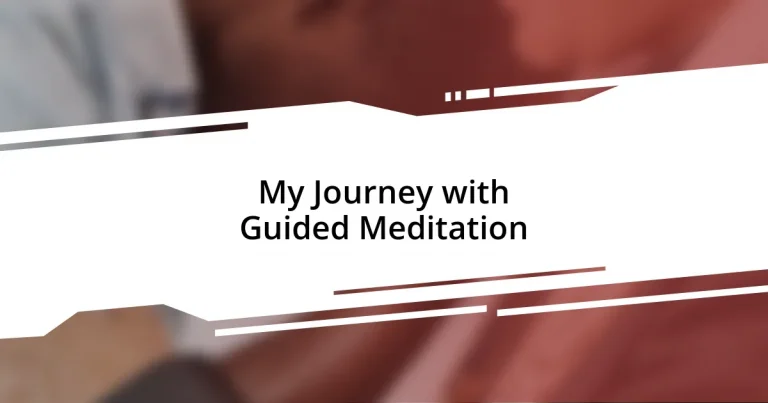Key takeaways:
- Guided meditation is accessible to all, promoting relaxation and self-discovery through visualization and deep breathing.
- Key benefits include reduced stress and anxiety, improved focus, and enhanced self-awareness, leading to emotional growth.
- Choosing the right meditation involves identifying personal goals, exploring different styles, and being open to experimentation.
- Establishing a routine, embracing variety, and practicing self-compassion are essential for maintaining a consistent meditation practice.

Introduction to Guided Meditation
Guided meditation is a practice that can transform your approach to relaxation and mindfulness. I remember the first time I tried it; I was skeptical, sitting cross-legged and listening to a soothing voice lead me through a visualization. Can you imagine sinking into a state of tranquility, where your thoughts drift away like clouds on a sunny day?
The beauty of guided meditation lies in its accessibility. Anyone can participate, regardless of experience level. I found that even just a few minutes of being led through deep breathing and visualization helped ease the noise of daily life, creating a sanctuary of calm. Have you ever felt overwhelmed and wished for a moment of stillness? Guided meditation offers that sanctuary.
As you embark on your journey with guided meditation, remember that it’s a personal experience. Each session feels like a gentle nudge towards self-discovery. I often left sessions feeling lighter, as if emotional burdens had been lifted. Isn’t it fascinating how a simple mental exercise can lead to profound insights and a deeper connection with ourselves?

Benefits of Guided Meditation
Guided meditation can bring about a significant reduction in stress and anxiety. I remember one particularly hectic week when everything felt overwhelming. During a just 15-minute guided session, I felt an immediate shift in my mindset—my heart rate slowed, and a wave of calm washed over me. It’s incredible how such a simple practice can serve as a powerful tool for emotional relief.
Another remarkable benefit of guided meditation is its ability to improve focus and concentration. In my experience, setting aside time each day for guided sessions has helped clear the mental clutter. When I return to my daily tasks, it’s as if a fog has lifted, allowing me to tackle challenges with newfound clarity. Have you ever noticed how distractions can pull you away from what truly matters? Guided meditation helps sharpen your mental focus and enhances productivity, making it easier to engage in meaningful activities.
Moreover, guided meditation fosters a deep sense of self-awareness and emotional well-being. I’ve had moments where, through visualization and introspection, I uncovered thoughts and feelings I didn’t even know I was holding onto. This journey inward sparked growth and healing—it’s like finding a part of myself that was hidden beneath layers of daily life. I urge you to explore your inner landscape. You may be surprised at the insights you’ll discover.
| Benefit | Description |
|---|---|
| Stress Reduction | Guided meditation promotes relaxation, helping to alleviate anxiety and stress effectively. |
| Improved Focus | It sharpens concentration and mental clarity, enabling better engagement in tasks. |
| Enhanced Self-Awareness | The practice encourages introspection, leading to emotional growth and understanding. |

Choosing the Right Guided Meditation
Choosing the right guided meditation can feel overwhelming, especially with the myriad of options available. I still remember scrolling through numerous apps and podcasts, wondering which voice would resonate with me. It helped me to consider my personal goals: was I seeking relaxation, focus, or a deeper emotional connection? Once I honed in on what I needed, I found it much easier to select a session that truly spoke to me.
Here are a few tips to guide you in your choice:
- Identify Your Intent: Clarify what you want from the meditation—relaxation, stress relief, focus, or self-discovery.
- Explore Different Voices and Styles: Try various instructors until you find a voice and style you connect with. Some voices are soothing, while others may energize you.
- Consider Duration: Assess how much time you can dedicate as guided meditations range from just a few minutes to an hour or more.
- Check Reviews: If you’re using an app, always look at user feedback to see what others found beneficial.
- Trial and Error: Don’t hesitate to experiment with different sessions. I discovered that what works one day might not resonate the next, and that’s perfectly okay.
By following these guidelines, you’ll not only make your journey easier but also more enriching.

Techniques for Effective Practice
Techniques for Effective Practice
One technique that I’ve found invaluable is establishing a consistent routine. Early on, I decided to meditate at the same time each day, creating a special space that was just for me. Have you ever noticed how habits develop when we dedicate a moment for ourselves? This consistency doesn’t just cultivate discipline; it builds a welcoming environment where mindfulness can flourish.
Another approach that has enriched my practice is utilizing visualization. During one session, I imagined myself in a tranquil forest, feeling the cool breeze and hearing the rustle of leaves. This imagery transported me and helped deepen my relaxation. I often ask myself: how can I incorporate more of these vivid mental images into my sessions? The answer lies in experimentation, allowing my imagination to lead the way.
Lastly, I have discovered the power of mindful breathing within guided meditation. Focusing on my breath not only centers my thoughts, but it also anchors me in the present moment. Whenever my mind starts to wander, consciously returning to my breath becomes a gentle nudge back to grounding myself. Have you ever noticed how a simple breath can reset your entire perspective? Embracing this technique has transformed my sessions, opening doors to deeper insights and tranquility.

Overcoming Challenges in Meditation
One of the biggest challenges I faced while meditating was dealing with distractions. At first, I would get so frustrated with the sounds around me—a dog barking, my phone buzzing, or even my thoughts racing. Eventually, I realized that instead of pushing those distractions away, I could acknowledge them. I began to see them as passing clouds rather than obstacles, allowing me to refocus on my breathing. Have you ever noticed how simply accepting distractions can transform your experience?
Another hurdle was the struggle with self-doubt. I vividly remember wondering if I was meditating “correctly” or if I was somehow doing it wrong. That doubt would often creep in, creating a barrier to my peace. It wasn’t until I reframed my mindset, recognizing that meditation isn’t about perfection but about presence, that I truly began to relax into the practice. Do you find yourself questioning your progress as well? Embracing the idea that every session is a step forward, no matter how small, has made all the difference for me.
Keeping motivation alive proved to be its own challenge too. Some days, I just didn’t feel like sitting down for meditation, but I found that creating a sense of community helped. I joined a local group, and suddenly, I wasn’t alone in my journey. Having a supportive environment where we could share experiences and encourage each other made those tough days infinitely easier. Have you ever felt the power of connection in your practice? That simple act of being part of something bigger reignited my passion and commitment.

Personal Experiences and Insights
Diving into guided meditation was a life-changing experience for me, but it wasn’t without its challenges. I remember the first time I tried a session; I felt lost and frustrated, questioning whether I was doing it “right.” Looking back, it makes me laugh to think how much pressure I put on myself. Have you ever felt like you’re racing against some invisible clock during meditation? It took time for me to realize that meditation is not a race, but rather a personal journey of self-discovery.
During my practice, I encountered moments of profound clarity, often triggered by unexpected thoughts. One day, I was lost in meditation, and suddenly I visualized an old friend I hadn’t spoken to in years. That memory flooded me with emotions—nostalgia, regret, and happiness all mingled together. It compelled me to reach out after the session, reminding me that meditation can serve as a bridge to reconnection. Have you ever had a realization that felt like a gentle nudge from your inner self? Those moments turned out to be the real treasures of my practice.
I’ve also come to appreciate the emotional rollercoaster that meditation can bring. There are times when I emerge from a session feeling lighter, as if I’ve shed emotional baggage. Other times, I find myself crying unexpectedly, releasing pent-up feelings I didn’t even know were there. Isn’t it interesting how meditation can unlock those hidden emotions? Embracing this vulnerability has truly taught me the strength that comes from being open to my feelings, transforming my relationship with myself in the process.

Tips for Sustained Practice
To maintain a consistent meditation practice, I found it immensely helpful to establish a routine. I carved out a specific time each day, treating it like an important appointment. Having that structure not only reduced my chances of skipping sessions but also made my meditation feel like an essential part of my lifestyle. Have you created a designated space or time for your practice? Finding your personal rhythm can make a world of difference.
Another tip that worked wonders for me was embracing variety in my sessions. Early on, I noticed that sticking to just one technique made things feel stale. So, I experimented with different guided meditations and styles, and soon I discovered a world of options—from mindfulness to loving-kindness. Mixing it up not only reignited my enthusiasm but also deepened my practice. Have you tried different techniques to keep things fresh?
Finally, I learned the value of self-compassion in my meditation journey. There were days when I sat down, only to find my mind wandering off to the grocery list or tomorrow’s tasks. Instead of chastising myself, I started to gently redirect my thoughts and accepted the experience for what it was. It’s amazing how giving yourself grace can transform frustration into acceptance. Isn’t it refreshing to know that progress isn’t about perfection?














